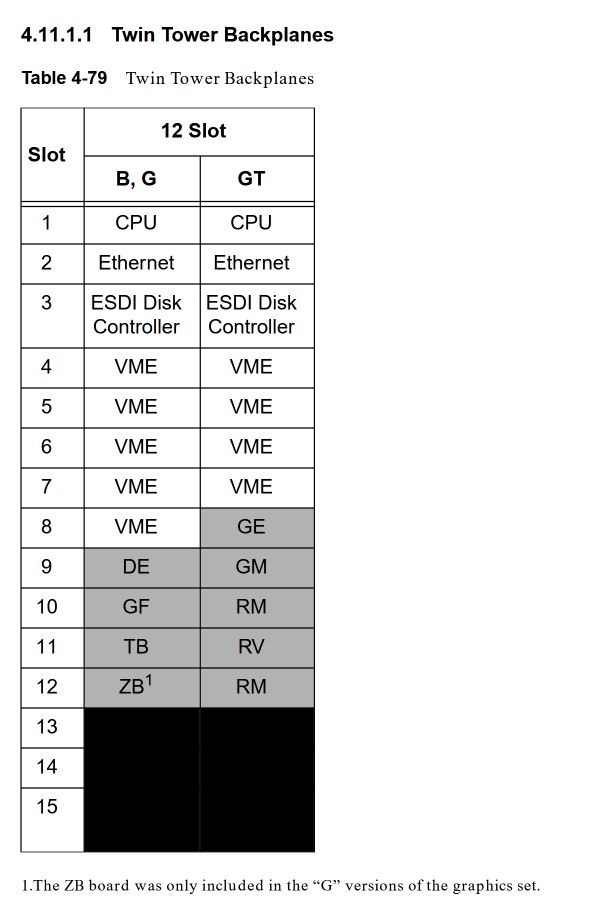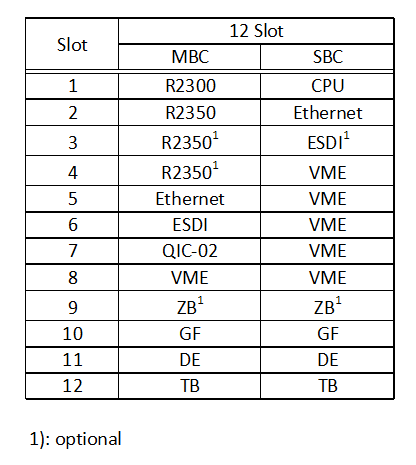(08-30-2025, 03:38 AM)robespierre Wrote: Have you seen this marketing summary?
[...]
Interestingly, it keeps the "Turbo Option" descriptor, even though as far as I'm aware, all 4D/50 and 4D/70 came with the IP4 which has an on-board SCSI channel.
An unusual amount of hardware is simply for colormapping: both the PMAP chips and the TB2 have independent color maps.
I had not seen this, thanks.
4D/50 and 4D/70 both came with IP4. Unlike the R2300 MBC used in the 4D/60, the IP4 had SCSI. What I find somewhat surprising is that this marketing document claims that the 4D/70 would have an ESDI controller and disk, but a SCSI tape drive. I can see why a 4D/60 upgraded with an IP4 would have kept it's ESDI controller and disk, but why would you ship a 4D/70 with ESDI disk and SCSI tape? Perhaps SCSI support was limited in early IP4 PROMs and/or IRIX versions? My 4D/50 has 4D1-2.1 PROMs and supports SCSI though.
My other Professional IRIS, a 4D/70 GT, was also all SCSI based. It has the ESDI ports on the bulkhead but they're not connected and neatly organized with tiewraps to avoid anything ending up in the fan tray, I assume.
This is also why I'm fairly sure this system, the 4D/50, originally did not have ethernet: the connector is on the bulkhead, but the flatcable was neatly organized with tiewraps with the (also unused) ESDI wiring. Yet this is contradicted by this document which claims all 4D/70's came with ethernet. Perhaps "no network" was an option for high security environments?
Another mystery I've not been able to unravel yet: the chassis. The main tower of this system has a sticker that says it's "013-0101-004, SBC CHASSIS REV H, 05/25/88". First of all, if there's an SBC chassis this implies there must have been an MBC chassis. IP4 was the single board successor to the MIPS R2300 MBC.
"This Old SGI" analyzes the backplane of the Professional IRIS and how it's divided in 3 sections. First 4 slots for the MBC, then 3 slots for VME options and finally 5 graphics slots. All 12 slots carry the VME P1 and P2b signals, but the graphics slots bus the P2 and P3 connectors to form a graphics bus. The first 4 slots bus P2ac, probably this is the memory bus between the R2300 CPU board and up to three R2350 memory boards with 4MB RAM each. My backplane follows this division as well so I assume it should be possible to install an R2300 MBC set if I ever found one.
So far I had imagined that perhaps the addition of SCSI would have been the difference between an MBC and an SBC chassis. The MBC used an ESDI controller and external wiring to the ESDI disk modules. It used a VME QIC-02 controller for the tape drive, again with external wiring I assume. The IP4 routes SCSI via P3. Would the MBC chassis have lacked SCSI routing to the drive tower? OTOH, considering the short time between the 4D/60 and the 4D/70, they must have been working on IP4 before the 4D/60 was released. Same for the graphics: 5 slots were reserved for graphics, but CLOVER1 is never more than 4. CLOVER2 ("GT") is always 5. Questions...

The Hardware Developer Handbook also differs from the layout as reverse engineered by "This Old SGI":
- The Handbook doesn't even mention the MBC. The CPU is in slot 1, the ethernet VME option card is in slot 2, not 5. That itself is not incorrect because the VME32 pins are bussed across all of the slots.
- It says the DE/GF/TB cards are in slots 9, 10 and 11, and slot 12 for the optional ZB. That's not even possible, because the DE and TB boards are connected at the front so the GF cannot be inbetween. In my case I has GF in slot 10, DE in slot 11 and TB in slot 12. Gerhard Lenerz puts them there too, with the optional ZB in slot 9. That actually makes sense, because if you add a ZB to a system and you had to move the GF, you'd need to change VME IACK/BG jumpers on the backplane. Inconvenient.
I guess it's safe to say the Professional IRIS was obsolete and largely forgotten by the time the Hardware Developer Handbook was written...
I think a more realistic slot assignment for the Clover1 TwinTowers would be:

![[Image: functional.jpg]](https://www.jurassic.nl/external/20250826-4d50/functional.jpg)
![[Image: collection.png]](https://jurassic.nl/images/collection.png)











 )
)
